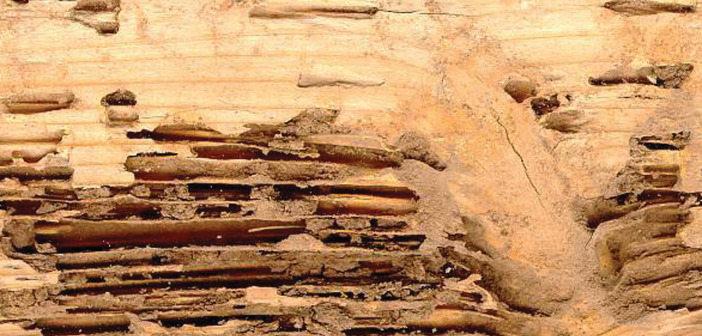Termites are a serious problem for homeowners in every part of the country. It is estimated that as many as 10 percent of homes sold today in some areas require professional termite control. One of the best defenses against termites is prevention. You should know the signs of a termite infestation so that you can get help before it is too late.
Mud Tubes or Patches
One of the first signs of an infestation is the appearance of a muddy substance on walls, ceilings or wooden fixtures. This substance looks like mud and is generated by the termites as a building material. You might notice long and irregular stretches of the mud. These tubes are really tunnels the termites use to move through your home. There might also be mud structures handing from pipes and ceilings. Termites use this material to patch holes created in walls to protect the colony. This mud means you already have an infestation.
Swarms of Flying Termites
Certain termites start to develop wings when the colony gets too large. These termites look like flying ants. They will take to the air in the spring and fall. They fly around looking for a mate and a place to start a new colony. If the termites do establish a new colony, then the queen could lay up to 30,000 eggs each day. The termites will all fly away at roughly the same time. If you see a swarm of flying termites, then it means your home might have a large colony living inside. It might also mean there is a large termite colony somewhere near your home or on your property that needs to be addressed.
Discarded Wings or Dead Termites
Flying termites do not keep their wings for very long. The termites will shed the wings as soon as they find a place to establish a new colony. This can result in piles of shed wings. You will find these piles around lights, corners and windows. This is a sign that termites are currently in your home. Another thing to look for is dead termites. Just one or two dead termites in your home can indicate an infestation is already underway.
Mounds of Droppings
Termites in your home do produce droppings as they eat. The droppings are called frass. The termites will leave behind large piles of frass in your home. These piles look like mounds of loose brownish or yellowish grains. You will usually find these along walls, in corners or possibly even inside of drawers and cabinets. Piles of frass appear only near a termite colony. You will need to call a termite control specialist if you find these frass piles in your home.
Unexplained Structural Damage
Termites are very destructive. They will slowly eat away the wood inside of your home. This means the studs in the walls, joists and even the decking in your roof. This damage can occur over the course of three to eight years. Unfortunately, it might go completely unnoticed. If you suddenly find unexplained damage to the wood structure of your home, then there is a good chance it could have been caused by termites. The only way to be sure is to have a professional inspection done.
Buckling Areas of Paint
According to Four Seasons Pest Control, termites work slowly. An early sign that you might have an infestation is if you see areas of buckling paint on your walls. This buckling occurs because the termites are moving and building tunnels underneath. This warps the surface of the wall. Buckling paint can mean termites are spreading throughout your house.
Small Holes in Wood
You should be looking for small holes in wood. These are left behind as the termites tunnel through the wood. The wood could be a windowsill, a doorframe or a decorative fixture in the home. The holes could also be found in wooden furniture. These holes are a strong sign that you likely have termites in your house.




